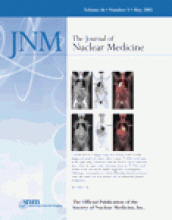Nuclear Medicine in Psychiatry
Andreas Otte, Kurt Audenaert, Kathelijne Peremans, Kees van Heeringen, and Rudi A. Dierckx eds.
New York, NY: Springer-Verlag, 2004, 561 pages, $229
This book is an in-depth technical review of the major aspects of nuclear brain imaging. Its main thrust appears to be towards those who design and implement neurologic research. However, the book is equally useful to the general nuclear medicine physician, as practical applications are well presented.
The book begins with a quote from Goethe, Faust I:
In motley pictures with a little clarity,
Much error and a spark of verity,
Thus can the best of drinks be brewed
To cheer and edify the multitude.
The ability to obtain excellent images of physiologic processes in the brain is in our hands. This book provides the information needed to translate known neurochemical pathways into useful imaging protocols. The editors have assembled the expertise of 40 authors who have contributed to the investigation of psychiatric disease through nuclear medicine technology.
As is fitting for publications in this millennium, a comprehensive review of molecular aspects of psychiatry is presented. With approximately 450 million people worldwide having mental and psychiatric diseases, there is a great need to understand and diagnose these disorders. Discoveries have led to a vast array of new radiolabeled ligands for investigation of neuroreceptor systems, allowing for pharmacologic challenge. For example, new tracers for imaging parkinsonian syndromes and dementias have allowed us to integrate nuclear imaging procedures of psychiatric disorders into our armamentariums.
The book progresses from basic science reviews, including reviews of neuroreceptors and psychopathology, into clinical applications. One section deals with technical aspects, and another with clinical utility. The introduction addresses diagnosis of psychiatric disease and the functional psychopathologic approach to brain receptor ligand studies. Joint involvement by the nuclear physician and psychiatrist is necessary to ensure that the information obtained is meaningful to the psychiatrist and can aid diagnosis.
Chapter 2 deals with instrumentation in nuclear medicine, and the authors have reviewed nuclear medicine cameras, imaging detection, and processing quite well. The section on imaging analysis is not comprehensive enough. One of the great obstacles to clinical acceptance of nuclear medicine neuroimaging stems from methods of analysis. Although analysis is discussed regarding various disorders, a broader review early on in the book would have been more helpful.
The next set of chapters gives timely reviews of biologic bases, brain-imaging radiopharmaceuticals, and clinical aspects related to each of these. A well-written chapter is included on the molecular aspect of G-protein–coupled receptor signaling. This chapter leads to sections on radioligands for central neuroreceptors, ligand tracer kinetics, and mechanisms of antipsychotic drugs. The end of the technical section reviews functional brain imaging and drug development. It also includes data on large studies of animals and serotonin-2A receptor imaging of dogs.
The clinical section begins with a review of functional psychopathology and classification of diseases and problems related to accurate stratification. A chapter on nuclear neuroimaging in child psychiatry briefly covers most areas. However, the section on attention deficit hyperactivity disorders (ADHD) should have been expanded. The references in this section are all 2002 or earlier and do not reflect newer articles categorizing various imaging aspects of ADHD. This inherent problem with book writing reflects the lag time associated with publication.
Subsequent clinical chapters discuss B-amyloid imaging (Alzheimer’s disease), psychiatric disorders in parkinsonian syndromes, and systemic lupus erythematosus (SLE). The chapter on SLE is excellent and provides details on the use of SPECT, PET, and MRI in this disorder. Throughout the clinical sections, the tables are nicely laid out and detail various tracers and their clinical utility.
For those interested in the medicolegal issues of brain imaging, an excellent review of whiplash injury and its delayed effects is presented. A special section introducing neuroimaging in its medicolegal realm is also provided.
Several chapters deal with schizophrenia, psychology, mood disorders, bipolar disorders, anxiety, and posttraumatic stress disorders. Sections on the utility of brain imaging in eating disorders and sleep disorders are well presented. Final chapters discuss aggressive behavior, hysteria, catatonia, and apathy.
Overall, this is an excellent text for those who perform SPECT or PET of the brain and those who design clinical trials for neuropsychiatric imaging. The text offers something for everyone and will be useful in sorting out various patterns of disease identified in the evaluation of neuropsychological and psychiatric disorders.







